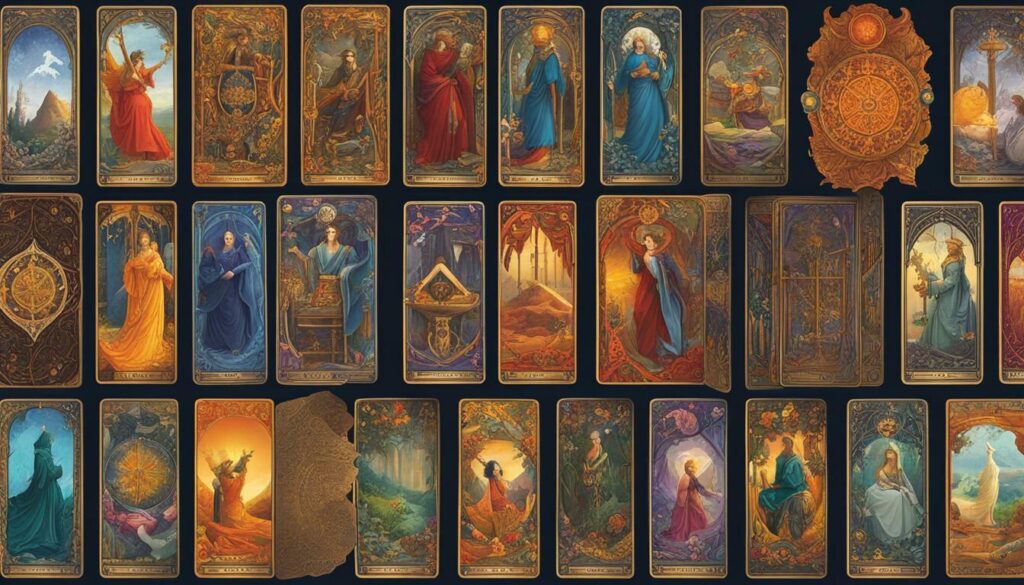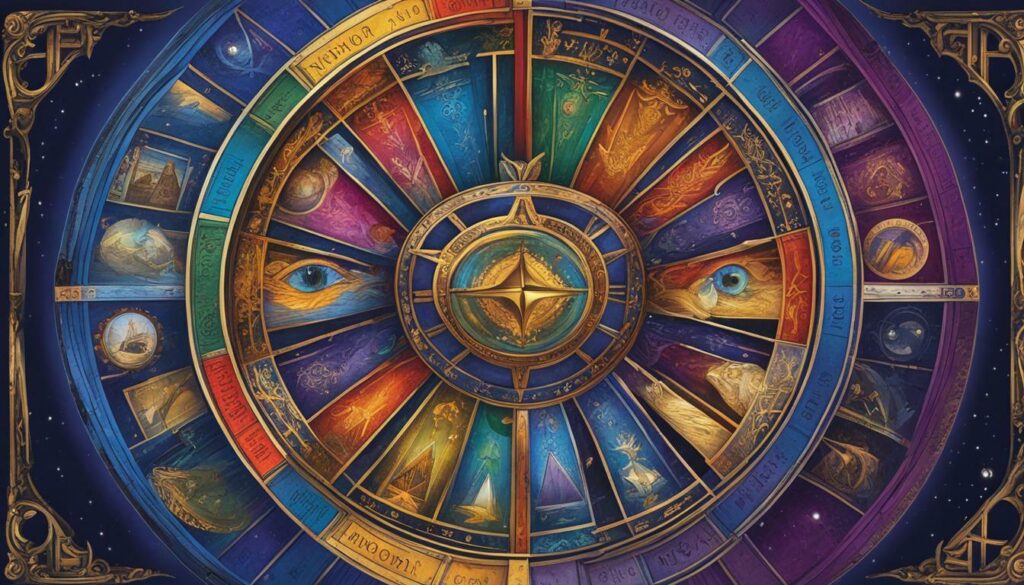Are you struggling to decipher the meanings of tarot cards? Do you find yourself spending hours memorizing tarot card keywords without making any progress? Look no further! We have a solution that will make learning tarot a breeze. By incorporating color-coded learning and tarot card keywords, we can enhance our understanding of tarot card meanings and improve our tarot card reading skills in no time.
What are tarot card keywords, you may ask? Tarot card keywords are words or phrases that encapsulate the essence and core meanings of each card. By understanding the keywords associated with each card, we can gain deeper insights into their interpretation and significance.
But how does color-coded learning fit into the equation? Color-coded learning is a powerful approach that harnesses the visual cues of different colors to enhance memory recall and learning retention. By associating specific colors with each card, we can streamline our tarot card interpretation and create more meaningful connections between the cards.
So, let’s dive in and learn how to use color-coded learning and tarot card keywords to unlock the secrets of the tarot.
Key Takeaways
- Tarot card keywords can enhance our understanding of tarot card meanings and improve our tarot card reading skills.
- Color-coded learning is a powerful approach that uses visual cues to enhance memory recall and learning retention.
- By incorporating color-coded learning and tarot card keywords, we can streamline our tarot card interpretation and create more meaningful connections between the cards.
The History of Tarot Cards
Have you ever wondered about the origins of tarot cards and how they came to be used for divination and spiritual guidance? Understanding the history of tarot cards can offer valuable insights into the symbolism and interpretation of the cards, making us better equipped to offer more insightful and meaningful readings.
The earliest recorded use of tarot cards can be traced back to 14th-century Italy, where they were used for playing games like tarocchi. It wasn’t until the late 18th century that tarot cards began to be used for divination, with French occultist Jean-Baptiste Alliette (also known as Etteilla) being one of the first to publish a tarot deck specifically for this purpose.
Since then, numerous tarot card decks have emerged, each with its own unique symbolism and interpretation. Some of the most popular tarot card decks include the Rider-Waite-Smith deck, the Thoth deck, and the Marseille deck. Each of these decks has its own distinct history and cultural significance, reflecting the diverse origins and backgrounds of tarot card readers and enthusiasts.
| Tarot Card Decks | Year of Publication | Author/Artist |
|---|---|---|
| Rider-Waite-Smith | 1910 | Arthur Edward Waite and Pamela Colman Smith |
| Thoth | 1944 | Aleister Crowley and Lady Frieda Harris |
| Marseille | 17th century | Unknown |
By familiarizing ourselves with the history of tarot cards and researching different tarot card decks, we can gain a deeper appreciation and understanding of the cards’ symbolism and interpretation. This knowledge can enhance our tarot reading abilities, enabling us to provide more accurate and insightful readings for ourselves and others.

Major Arcana vs. Minor Arcana
When it comes to tarot card spreads, differentiating between the major arcana and minor arcana is essential in understanding the depth and meaning of a reading. The major arcana consists of 22 cards, each one representing a major life lesson or spiritual journey. These cards are typically depicted with significant figures and symbolic imagery, such as The Fool, The Tower, or The Sun.
The minor arcana, on the other hand, consists of 56 cards, divided into four suits: cups, wands, swords, and pentacles. Each suit represents a different aspect of daily life and is associated with specific meanings. Cups represent emotions and relationships, wands represent creativity and passion, swords represent thoughts and communication, and pentacles represent material wealth and stability.
When interpreting a spread, the presence of major arcana cards typically signifies significant life events or lessons that need attention, while minor arcana cards represent more everyday occurrences or influences. By understanding the unique characteristics of each arcana, we can gain a more comprehensive understanding of the reading and provide more insightful guidance to those seeking answers.

It’s important to note that while the major and minor arcana have distinct characteristics, they work together to create a comprehensive and complex tapestry of tarot card interpretation. The relationship between the two is crucial in unlocking the secrets of a reading and understanding its true message.
We will delve deeper into the intricacies of tarot card interpretation and how to enhance your tarot journey further in the following sections.
Unveiling Tarot Card Symbolism
As tarot readers, we know that the symbolism of tarot cards is of utmost importance. The rich imagery within each card offers a wealth of hidden meanings, providing insight and clarity to the interpretation of a reading.
Understanding tarot card symbolism is a dynamic process that requires both intuition and knowledge. Tarot cards hold multiple layers of meaning, and it is our job as readers to unravel these intricacies and discern their relevance to the querent.
For example, the High Priestess card is often associated with intuition, secrets, and hidden knowledge. The symbol of the crescent moon on her crown represents the cycles of life and the waxing and waning of the moon, while the pillars behind her suggest duality and balance. These symbols all contribute to the overall interpretation of the card, revealing deeper insights into the querent’s situation.
It is crucial to note that tarot card symbolism can vary depending on the deck used and the reader’s personal interpretation. Thus, it is essential to familiarize ourselves with the specific symbolism present in the decks we use and to remain open to new insights and perspectives.
By honing our understanding of tarot card symbolism, we can provide more nuanced and insightful readings, uncovering hidden meanings and messages within the cards.

Incorporating the symbolism of tarot cards is essential in unlocking their true meaning and providing guidance to querents.
The Power of Tarot Card Keywords
When learning tarot, memorizing the meanings of each card can be overwhelming. That’s where tarot card keywords come in handy. By distilling the essence of each card into a few words or phrases, we can simplify the learning process and accelerate our understanding of the cards.
Tarot card keywords are concise anchors that encapsulate the core meanings of each card. For example, the Fool card can be distilled into keywords such as “new beginnings,” “risk-taking,” and “innocence.” By familiarizing ourselves with these keywords, we can quickly recall the meaning of each card during readings.
Not only do tarot card keywords make learning easier, but they can also enhance our tarot readings. By incorporating keywords into our interpretation of the cards, we can provide more nuanced and insightful readings. When we see the Knight of Wands, for instance, we may immediately associate it with keywords such as “action,” “passion,” and “leadership,” allowing us to offer more personalized guidance to our querent.

Using tarot card keywords is an effective way to streamline the tarot learning process and improve our tarot reading abilities. As we become more comfortable with the keywords, they become integrated into our knowledge of the cards, allowing us to offer more confident and accurate readings.
If you’re just starting on your tarot journey, we recommend focusing on learning the tarot card keywords first. By mastering these anchors, you’ll quickly gain a better understanding of tarot card meanings and be able to provide more insightful readings.
Enhancing Tarot Journey with Color-Coded Learning
Color-coded learning is an innovative way to accelerate our tarot journey, by creating visual connections between tarot cards and specific colors. By associating colors with tarot card spreads, we can streamline tarot card interpretation and strengthen our memory recall, allowing us to provide more insightful readings.

For instance, we can associate the color red with the root chakra, which signifies stability and grounding. When interpreting the base chakra card in a tarot spread, we can use the color red as a mnemonic device to recall its core meaning, allowing us to provide a more accurate interpretation.
Color-coded learning is particularly effective in learning the minor arcana, which is often challenging for beginners due to the number of cards involved. By associating specific colors with each suit, we can simplify the learning process and remember each card’s core meaning more easily.
For example, we can associate the color green with the suit of pentacles, which symbolizes material wealth and abundance. By visualizing the color green, we can easily recall the essence of the pentacles suit during a tarot reading, allowing us to provide more meaningful insights to our clients.
Ultimately, color-coded learning is a powerful tool that can enhance our tarot journey and transform the way we approach tarot card interpretation. By creating visual connections between tarot cards and colors, we can unlock the secrets of the tarot faster and offer more insightful readings to those seeking guidance and clarity in their lives.
The Conclusion: Unlocking the Secrets of Tarot
We hope this article has shed some light on how to learn tarot faster with color keywords. By incorporating these visual cues, we can enhance our understanding of tarot card meanings and improve our tarot card reading skills. However, understanding the history, symbolism, and interpretation of tarot cards is just as important in becoming a proficient tarot reader.
When exploring different tarot card decks, we can gain valuable insights into the symbolism and interpretation of the cards. Differentiating between the major arcana and minor arcana is crucial in comprehending the depth and significance of tarot card spreads. By unraveling the tarot card symbolism, we can develop a more nuanced understanding of their interpretation, enabling us to provide more insightful readings.
As we continue on our tarot journey, incorporating tarot card keywords can accelerate our learning journey, making it easier to recall and interpret the cards during readings. By associating specific colors with tarot cards, we can strengthen our memory recall, streamline tarot card interpretation, and create more meaningful connections between the cards during readings.
In conclusion, by embracing color-coded learning and understanding the history, symbolism, and interpretation of tarot cards, we can embark on a transformative tarot journey, offering guidance and insight to others.
FAQ
Q: How can color-coded learning help me learn tarot faster?
A: Color-coded learning can enhance your understanding of tarot card meanings by associating specific colors with each card. This makes it easier to recall and interpret the cards during readings, speeding up your learning process.
Q: Why is understanding the history of tarot cards important?
A: Understanding the history of tarot cards provides valuable insights into their origins and development. By familiarizing yourself with different tarot card decks, you can gain a deeper understanding of the symbolism and interpretation of the cards.
Q: What is the difference between major arcana and minor arcana?
A: The major arcana and minor arcana are two distinct categories of tarot cards. The major arcana represents significant life events and spiritual lessons, while the minor arcana focuses on everyday experiences and influences within specific areas of life. Differentiating between the two is crucial in interpreting tarot card spreads.
Q: How does symbolism in tarot cards contribute to interpretation?
A: Tarot cards are rich in symbolism, with each image carrying hidden meanings and messages. By unraveling the symbolism within the cards, you can develop a more nuanced understanding of their interpretation, allowing for more insightful readings.
Q: What is the significance of tarot card keywords?
A: Tarot card keywords serve as anchors in the learning process. They encapsulate the essence and core meanings of each card, making it easier to recall and interpret during readings. Incorporating tarot card keywords can accelerate your learning journey and deepen your understanding of the cards.
Q: How can color-coded learning enhance my tarot journey?
A: Color-coded learning harnesses the power of visual cues to enhance your tarot journey. By associating specific colors with tarot cards, you can strengthen memory recall, streamline interpretation, and create meaningful connections between the cards during readings.

